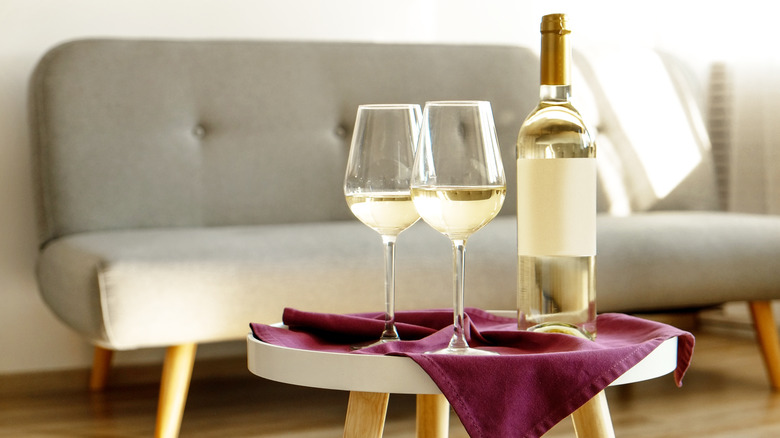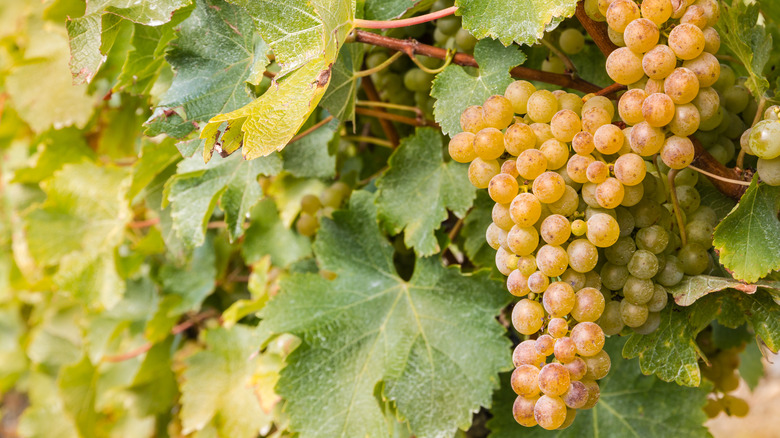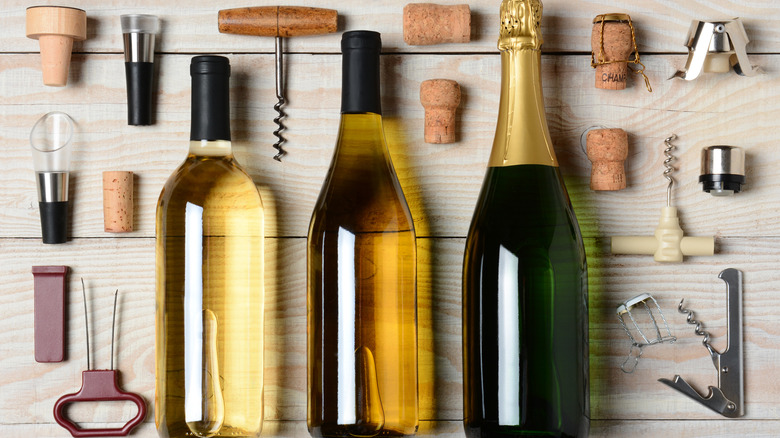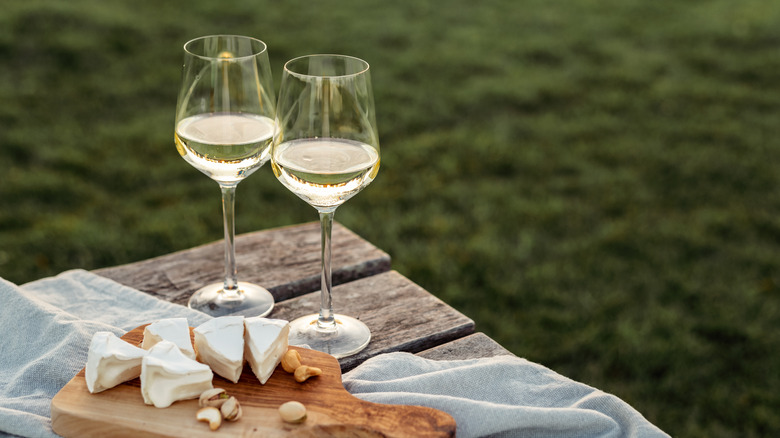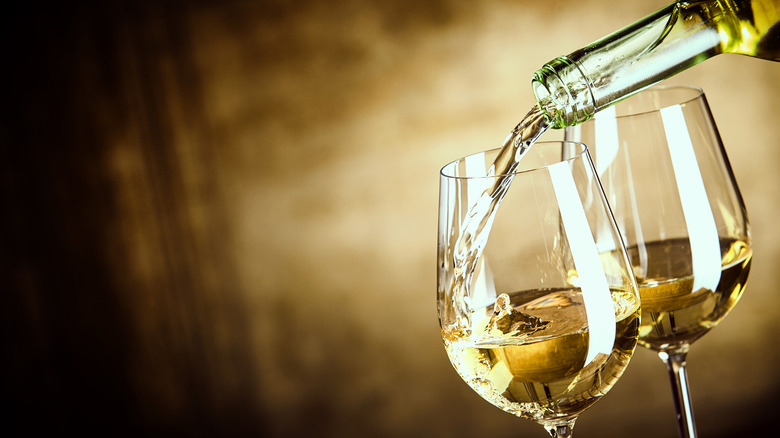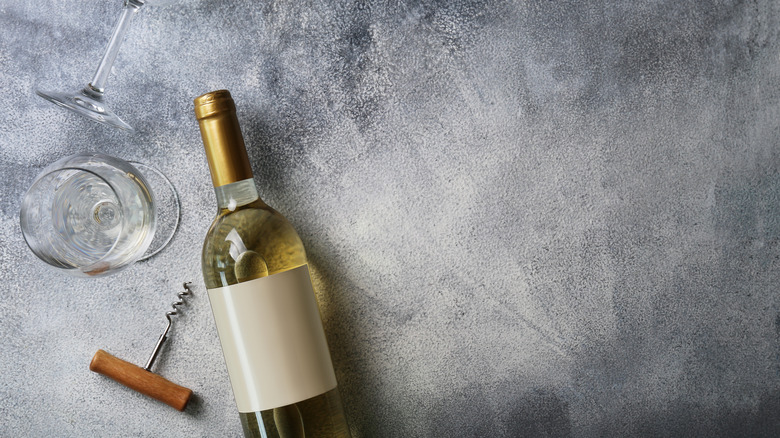What Is Sauvignon Blanc And What Does It Taste Like?
Though it took some time in the wine world for Sauvignon Blanc to become the popular white wine that it is today, it has evolved into a notable wine for those who partake in drinking it. Known for its refreshing and crisp nature, Sauvignon Blanc is also very aromatic with high acidity. The grapes' qualities translated into the bottle are what have made it one of the most popular varietals in the U.S., but that wasn't always the case.
Sauvignon Blanc was initially grown in Bordeaux as a wild, almost weed-like grape, according to Vine Pair. Instead of using the grapes to make a new kind of wine, French winemakers originally added them into Sauterne, a sweet dessert wine. Eventually, the grape made its way to the Loire Valley's Sancerre appellation. There it was cultivated and used on its own to make Sancerre wine, named after the French region in which it was made. The new wine became very popular, and it is no different from the Sauvignon Blanc we know today. It wasn't until the 1980s, when the grape made its way to New Zealand, that Sauvignon Blanc became the popular wine with bright fruity notes that people now recognize and love.
How is Sauvignon Blanc made?
Generally, Sauvignon Blanc is made using stainless steel tanks in which it is fermented at temperatures between 42 degrees Fahrenheit and 50 degrees Fahrenheit, per Winemaker Magazine. After the wine has fermented and developed alcohol, the wine is fined and filtered before being bottled for additional fermentation. After being bottled, Sauvignon Blanc can be enjoyed on the younger side — just about five months after the grapes fermented.
While the winemakers themselves can control much of how the grape presents itself during the winemaking process, one factor that greatly contributes to the overall final product is where the grapes are grown. Cooler climates such as that of Sancerre produce a wine with more minerality than the warmer climates of New Zealand, which tend to be very aromatic with bright, floral, and fruity notes. So if you like Sauvignon Blanc, but those bottles from New Zealand are a little too loud for you, then you might want to try one from Sancerre to get the French interpretation of the grape. You might find you like the varietal more than you imagined you would.
Sauvignon Blanc is similar to Chardonnay
Each grape varietal has its own distinct base flavors and aromas. Though the winemakers and the regions in which the grapes are grown impact the final wine, you can still tell wines apart based on their base grapes — even if it is two white wines.
However, Chardonnay is quite similar to Sauvignon Blanc in that they both originate from France and both can be made using the same technique. However, many chardonnays are made using oak barrels instead of stainless steel tanks. Not to mention, both grape varietals are used to make both bold bottles and more reserved, subtle takes too. Sauvignon Blanc is also Sancerre, while Chardonnay is also known as Chablis.
Though there is some overlap between Sauvignon Blanc and the base flavors that present themselves in other white wines, Sauvignon Blanc will always have a collection of citrus and melon flavors with a medium to light body. Other white wines can easily be richer and more full-bodied than a light, crisp Sauvignon Blanc.
What does Sauvignon Blanc taste like?
There are several characteristic base flavors you can likely detect when sipping on a crisp glass of Sauvignon Blanc. The white wine is known for displaying bright, citrus fruits such as grapefruit, white peach, and passion fruit, as well as gooseberry and honeydew melon. These base notes should surface as you sample the wine and after you've taken a few deep breaths of the nose. "Nose" refers to a wine's scent. The aroma of Sauvignon Blanc tends to present more of a floral scent, but it can also smell fruity too.
Sauvignon Blanc is a very acidic wine, so you'll likely feel the saliva forming and running down the insides of your cheeks. According to Wine Folly, this varietal also has a medium range ABV (alcohol volume) between 11.5% and 13.5%. The dry wine tends to be a medium to light-bodied wine with a small amount of tannin, too. Tannins are fibers left behind in the finished wine that give structure to the wine and can also leave a dry sensation on the tongue. The medium to light body means it has a medium to light thickness, or viscosity.
How to drink Sauvignon Blanc
Depending on the varietal and style of the wine, it should be served within a certain range of temperatures to attain its best taste without muting any desirable qualities. According to Wine Folly, Sauvignon Blanc should be exposed to as little air as possible prior to serving, and it should be chilled between 45 and 55 degrees Fahrenheit. You will also want to use a white wine glass to ensure the wine hits the palate correctly. Using the wrong wine glass can alter the nose and the notes of the wine, so glassware is important to consider when serving wine.
Sauvignon Blanc can be aged for a couple of years when stored properly in a cellar. However, it tends to be enjoyed young. Usually, the wine is consumed after a few months of being bottled. However, you can allow Sauvignon Blancs to age for three to five years and still be enjoyable.
Where to buy Sauvignon Blanc Wines
Because Sauvignon Blanc has become such an incredibly popular wine, you can easily find it on the shelves of your local grocery store. It tends to be on most wine lists at bars and restaurants too, so you just need to know if you prefer a bold glass from New Zealand or a more subdued one from France. Of course, other regions also produce wonderful Sauvignon Blancs worth trying. You can order some amazing bottles online or use an app like Vivino to find where you can buy highly rated bottles. Another great place to shop is the global Foley Family Wines, which uses sustainable growing and processing methods.
Some wines to look for include La Crema Sauvignon Blanc 2020 and Justin Sauvignon Blanc 2020. The latter wine has a very high acidity and is very aromatic, while La Crema is more subtle. Opt for the 2018 Roth Estate Sauvignon Blanc for a solid pick or splurge a little more for the 2019 Chalk Hill Sauvignon Blanc if you already know you love this grape.
Nutritional information for Sauvignon Blanc
In terms of nutritional value, Sauvignon Blanc is a decent option. Per each five fluid ounce serving, Sauvignon Blanc has 119 calories, three grams of carbs, and 0.1 grams of protein, per Nutrition Value. That means only 10% of its calories are from carbs, while the majority are from the alcohol itself. Most white wines only have around 1.5 grams of sugar per a five fluid ounce serving size, according to Open Fit, so you can choose Sauvignon Blanc as a mindful option.
According to WebMD, white wine tends to be high in phenolic acids, which means a glass of white wine is loaded with good-for-you antioxidants. Enjoying a glass of white wine can also help reduce your stress hormones, which is also great for your overall health. And while white wine isn't quite as heart-healthy has red wine, Sauvignon Blanc still a good option with admirable health benefits.
